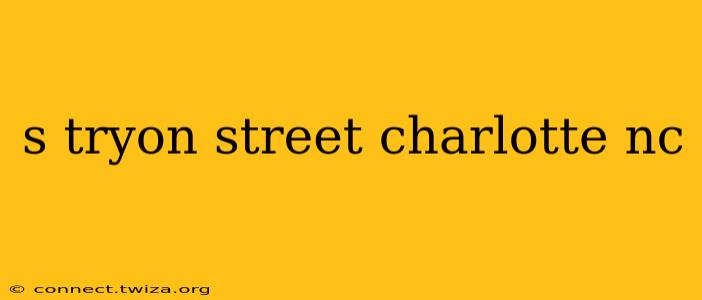Tryon Street, a major thoroughfare running through the heart of Charlotte, North Carolina, is far more than just a street; it's a living tapestry woven with threads of history, culture, and modern urban life. From its humble beginnings to its current status as a dynamic center of activity, Tryon Street reflects the evolution of Charlotte itself. This article delves into the rich history and vibrant present of Tryon Street, answering common questions and highlighting what makes it such a captivating destination.
What is Tryon Street known for?
Tryon Street is renowned for its diverse mix of architectural styles, reflecting Charlotte's growth over centuries. It boasts stunning examples of Victorian architecture alongside sleek, modern skyscrapers. This blend creates a unique visual landscape that's both historically significant and undeniably contemporary. Beyond architecture, Tryon Street is also known for its thriving retail scene, its concentration of cultural institutions, and its role as a central artery connecting various parts of the city. It's a place where history meets modernity, offering something for everyone.
What is the history of Tryon Street?
The history of Tryon Street is intrinsically linked to the history of Charlotte itself. Named after William Tryon, the colonial governor of North Carolina, the street served as a crucial pathway in the early days of the city's development. It initially followed a Native American trail, evolving to become a central route for commerce and transportation. Over time, it witnessed the construction of significant buildings, reflecting the changing economic and social landscape of Charlotte. From modest early structures to the imposing skyscrapers of today, Tryon Street's architecture tells a compelling story of growth and transformation.
What are some of the landmarks on Tryon Street?
Tryon Street is home to numerous landmarks that contribute to its distinctive character. These include:
- The Levine Museum of the New South: This acclaimed museum explores the complex history and culture of the American South following the Civil War.
- The Bechtler Museum of Modern Art: Showcasing a significant collection of modern and contemporary art, this museum offers a sophisticated cultural experience.
- The Duke Energy Center: A prominent skyscraper that serves as the headquarters for Duke Energy, it's a defining feature of the Charlotte skyline.
- Several historic churches and buildings: These architectural gems offer glimpses into Charlotte's past and represent various architectural styles.
- Numerous high-rise residential and commercial buildings: Reflecting Charlotte's modern economic growth.
Where is Tryon Street located in Charlotte?
Tryon Street runs predominantly north-south, cutting through the heart of Uptown Charlotte. It's easily accessible by car, public transportation, and on foot. Its central location makes it a convenient hub for exploring other parts of the city.
What are some things to do on Tryon Street?
Tryon Street offers a wide array of activities and attractions:
- Explore the museums: Immerse yourself in art, history, and culture.
- Enjoy shopping: Discover a variety of retail options, from high-end boutiques to unique shops.
- Dine at diverse restaurants: Experience Charlotte's vibrant culinary scene with a wide selection of restaurants offering various cuisines.
- Attend events and performances: Many venues on Tryon Street host concerts, festivals, and other events throughout the year.
- Admire the architecture: Take a stroll and appreciate the diverse architectural styles that showcase Charlotte's history and growth.
Is Tryon Street safe?
Like any major urban street, safety on Tryon Street depends on the time of day and specific location. However, Uptown Charlotte, where the majority of Tryon Street is located, generally maintains a high level of security and police presence, particularly in the well-lit and highly trafficked areas. It is advisable to exercise typical city street awareness and take precautions as you would in any busy urban environment.
What is the best way to get around Tryon Street?
Tryon Street is easily accessible by various means:
- Walking: The area is very walkable, allowing for leisurely exploration.
- Public Transportation: The LYNX Blue Line light rail runs close to Tryon Street, providing convenient access.
- Driving: Numerous parking garages and street parking options are available (though can be expensive and limited during peak hours).
- Ride-sharing services: Uber and Lyft are readily accessible.
Tryon Street is a vital artery in the heart of Charlotte, NC, reflecting the city's dynamic blend of past and present. Its rich history, vibrant atmosphere, and diverse offerings make it a must-visit destination for anyone exploring this thriving Southern city.
